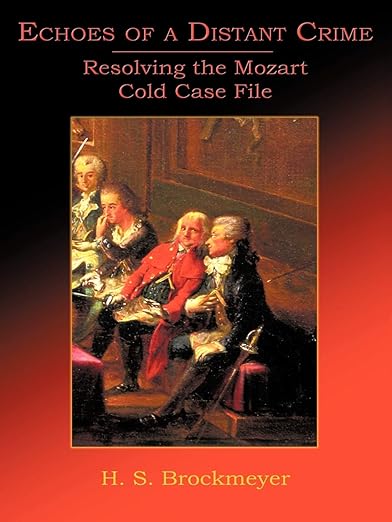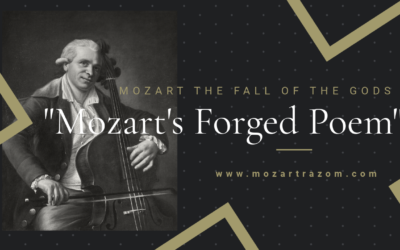Unveiling Hidden Plots
The True Caregiver
Article written by H. S. Brockmeyer
Wolfgang Amadeus Mozart’s final days have always been shrouded in mystery, both due to the circumstances of his death and the ambiguity surrounding who genuinely cared for him as his life ebbed away.
The True Caregiver by H. S. Brockmeyer invites us to reassess whether it was Mozart’s wife, Constanze, or her sister, Sophie Haibl, who provided true devotion during those distressing moments.
By using letters, diaries, and firsthand accounts, Brockmeyer examines emotional dynamics, medical practices, and religious tensions, encouraging readers to question the historical narratives we have long taken for granted.
“Memory, myth, and selective storytelling have crafted the Mozart we think we know, but the truth is far more complicated.”
Echoes of a Distant Crime: Resolving the Mozart Cold Case File
Unraveling the Mystery Behind the Final Moments and Support System of Wolfgang Amadeus Mozart.
Wolfgang Amadeus Mozart’s final days have always been shrouded in mystery, not only because of the enigmatic circumstances surrounding his death but also due to the ambiguity about who truly cared for him as his life ebbed away. In The True Caregiver by H. S. Brockmeyer, we are invited to reassess long-held beliefs about the key figures by Mozart’s side during those distressing last moments.
One topic that has never been debated—or even noticed until now—is the role of Sophie Haibl in Mozart’s final days. Brockmeyer is the first to uncover the significance of the plaque over their apartment in Mozartplatz and the gravestone in the Kommunalfriedhof in Salzburg, which honor Sophie as the ‘true caregiver’ in Mozart’s last hours. She invites us to question why Mozart died in Sophie’s arms, not Constanze’s, and explores Sophie’s often-overlooked impact as a devoted caretaker.
Using letters, diaries, and testimonies from contemporaries, the author paints a vivid picture of Mozart’s final days. She examines Sophie’s account of Mozart’s death, including the controversial tale of the physician, Dr. Closset, who preferred attending the theater over attending the stricken composer. The narrative delves into the medical practices of the time, such as Mozart’s infamous bloodletting treatment, and questions the effectiveness—and perhaps the negligence—of these methods.
Brockmeyer expands on the emotional and social dynamics at play. She explores how Sophie’s story has been elevated over the years, potentially to shield Constanze from criticism or to create a more compelling narrative of sisterly devotion. Sophie’s account, though filled with intimate details, is analyzed for possible exaggerations or errors, as she recounted them many years later. Brockmeyer critically assesses whether Sophie’s memory, shaped by time and perhaps her desire to appear virtuous, stands up to scrutiny against the surviving historical evidence.
Constanze emerges as a complex and often misunderstood figure. In previous accounts, she has been harshly judged and accused of selfishness or neglect, yet Brockmeyer urges a reconsideration. She argues that despite the criticisms, Constanze played a crucial role in preserving Mozart’s legacy. After his death, she worked tirelessly to promote his music and secure his place in history. Brockmeyer emphasizes that this dedication, often overlooked, shaped our modern understanding of Mozart’s genius.
The article also touches on broader cultural and religious tensions. Brockmeyer doesn’t shy away from discussing the strained relationship between Mozart’s Masonic beliefs and the Catholic Church. One of the most poignant details is the refusal of a priest to administer the last rites. This refusal deepens the mystery and adds a layer of religious and philosophical conflict that colored the composer’s final days. The author also highlights how Mozart’s ties to the Freemasons may have influenced both his life and the circumstances surrounding his death, complicating our understanding of those around him.
In the end, Brockmeyer acknowledges that some details about Mozart’s death may forever remain a mystery. Still, she encourages readers to think critically about who truly cared for Mozart and to question the accounts we often take for granted. This nuanced approach reveals the complexities of human relationships and the ways in which history is constructed, layer by layer, through memory, myth, and selective storytelling.
![Sophia_Weber_Haibl Portrait of Maria Sophie Weber (1763[1]–1846), singer, the younger sister of Wolfgang Amadeus Mozart's wife, Constanze](https://www.mozartrazom.com/wp-content/uploads/2024/11/Sophia_Weber_Haibl.jpg)
Portrait of Maria Sophie Weber (1763–1846)
To uncover more about the compelling narrative surrounding Mozart’s final days and the complex roles played by those closest to him, you can download the complete article by H. S. Brockmeyer at the link below.
Download the full document (pdf)
You May Also Like
#3 Leopold Mozart’s Literary Theft
Hidden within the Mozarteum’s archives lies a poem that has long been hailed as a tribute to the young Mozart children. But behind this innocent façade is a story of deception, literary theft, and one father’s ambition to rewrite history.
#4 The Golden Spur
While often portrayed as a prestigious award, the Golden Spur (Speron d’Oro) granted to Mozart in 1770 was far from a reflection of his musical genius. In this article, we delve into the true story behind this now-forgotten honour, its loss of value, and the role of Leopold Mozart’s ambitions in securing it.
Mozart Unmasked: The Untold Story of His Italian Years
Explore the lesser-known side of Wolfgang Amadé Mozart’s early years in Italy. ‘Mozart in Italy’ unveils the complexities, controversies, and hidden truths behind his formative experiences, guided by meticulous research and rare historical documents. Delve into a story that challenges the traditional narrative and offers a fresh perspective on one of history’s most enigmatic composers.
Another Example of Borrowed Genius
The myth of Mozart’s genius continues to collapse under the weight of his reliance on others’ ideas, with Leopold orchestrating his son’s supposed early brilliance.
A Genius or a Patchwork?
The genius of Mozart had yet to bloom, despite the anecdotes passed down to us. These concertos were not the work of a prodigy, but a collaborative effort between father and son, built on the music of others.
Myth, Reality, and the Hand of Martini
Mozart handed over Martini’s Antiphon, not his own, avoiding what could have been an embarrassing failure. The young prodigy had a lot to learn, and much of what followed was myth-making at its finest.







